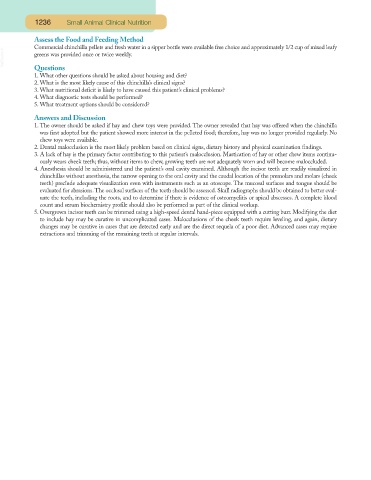Page 1186 - Small Animal Clinical Nutrition 5th Edition
P. 1186
1236 Small Animal Clinical Nutrition
Assess the Food and Feeding Method
Commercial chinchilla pellets and fresh water in a sipper bottle were available free choice and approximately 1/2 cup of mixed leafy
VetBooks.ir greens was provided once or twice weekly.
Questions
1. What other questions should be asked about housing and diet?
2. What is the most likely cause of this chinchilla’s clinical signs?
3. What nutritional deficit is likely to have caused this patient’s clinical problems?
4. What diagnostic tests should be performed?
5. What treatment options should be considered?
Answers and Discussion
1. The owner should be asked if hay and chew toys were provided. The owner revealed that hay was offered when the chinchilla
was first adopted but the patient showed more interest in the pelleted food; therefore, hay was no longer provided regularly. No
chew toys were available.
2. Dental malocclusion is the most likely problem based on clinical signs, dietary history and physical examination findings.
3. A lack of hay is the primary factor contributing to this patient’s malocclusion. Mastication of hay or other chew items continu-
ously wears cheek teeth; thus, without items to chew, growing teeth are not adequately worn and will become maloccluded.
4. Anesthesia should be administered and the patient’s oral cavity examined. Although the incisor teeth are readily visualized in
chinchillas without anesthesia, the narrow opening to the oral cavity and the caudal location of the premolars and molars (cheek
teeth) preclude adequate visualization even with instruments such as an otoscope. The mucosal surfaces and tongue should be
evaluated for abrasions.The occlusal surfaces of the teeth should be assessed. Skull radiographs should be obtained to better eval-
uate the teeth, including the roots, and to determine if there is evidence of osteomyelitis or apical abscesses. A complete blood
count and serum biochemistry profile should also be performed as part of the clinical workup.
5. Overgrown incisor teeth can be trimmed using a high-speed dental hand-piece equipped with a cutting burr. Modifying the diet
to include hay may be curative in uncomplicated cases. Malocclusions of the cheek teeth require leveling, and again, dietary
changes may be curative in cases that are detected early and are the direct sequela of a poor diet. Advanced cases may require
extractions and trimming of the remaining teeth at regular intervals.

